Footballs in space, mind-controlled machines and long-lasting bubbles join your questions on this week's Naked Scientists Question and Answer show. We discover the feminine side of prostate cancer and the robot that can walk up walls, and also hear how a computer has designed the next generation of mosquito repellents. Plus, we revisit the Phoenix mission on Mars, and also find out how surfing the internet can contribute more carbon to climate change than surfing the skies in an aeroplane! Plus, in Kitchen Science, Dave demonstrates a psychedelic effect with some milk.
In this episode

- Why does the road surface appear to shimmer when it’s hot?
Why does the road surface appear to shimmer when it’s hot?
When air is hot it expands and light will go through hot air slightly faster than cold air. When light changes its speed at an angle it will bend like when it goes into glass or something. You get lots of turbulence with air moving up which light will go through faster. So you get light bending in all sorts of directions which change as the air moves and you get this turbulence effect. The same effect makes stars twinkle, as you get turbulence up in the atmosphere which bends the light coming from stars which makes them twinkle on and off. Sometimes they come towards you, sometimes they go the other way.
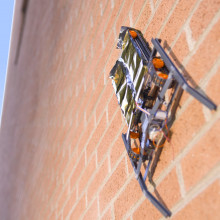
Wall climbing robots
Robots are becoming more and more important in war zones, disaster areas, and in every day life, in order to view places people cant access easily or safely. At the moment flying robots can't last for very long because they use so much power, and ground based robots are constrained to fairly flat surfaces.
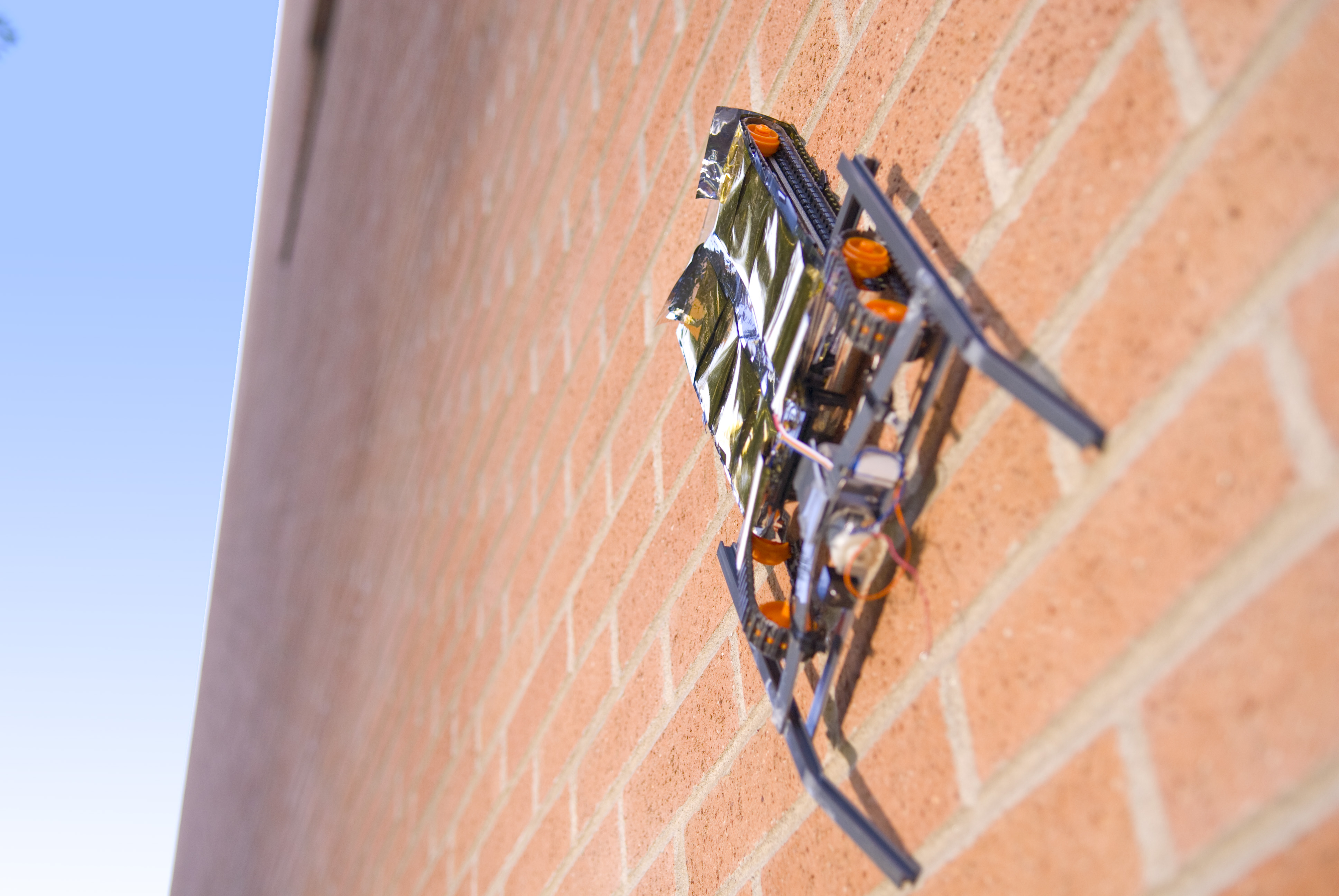 Various groups have tried to make wall climbing robots based on suction pads, or reusable gecko adhesive, but none of them work on loose surfaces. Researchers from SRI international have invented a really elegant way to make robots climb walls, using the same principle as how you can rub a balloon on your hair and then stick a balloon to a wall.
Various groups have tried to make wall climbing robots based on suction pads, or reusable gecko adhesive, but none of them work on loose surfaces. Researchers from SRI international have invented a really elegant way to make robots climb walls, using the same principle as how you can rub a balloon on your hair and then stick a balloon to a wall.
This works by a process called electro-adhesion, the balloon sticks because when you rub it, you build up a large negative charge. When this is near the wall, the part of the wall close to the balloon will become positive and attract the balloon, this attraction is large enough for friction to hold it up. But on a conducting wall the charge will escape and the balloon will fall off quickly.
Harsh Prahlad and collegues have built a robot on the same principle, it has a series of electrodes insulated form the wall by a thin layer of flexible rubber. The robot charges up these electrodes to several thousand volts which then attract the wall in the same way as the balloon, and because the electrodes are insulated it will work on metal surfaces as well.
The robot will climb walls which are dusty, and can support between 20 and 140g per square cm of clamping area. But the researchers are still working on walls that are wet, as unfortunately the robot sticks to the water rather better than the wall...!
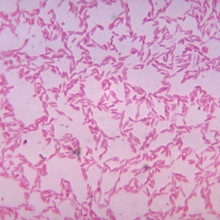
Bacterial basis of "good bugs" and probiotics
Scientists have found convincing evidence for the basis of "good bacteria" and how they contribute to health. Caltech researcher Sarkis Masmanian and his colleagues, writing in this week's Nature, have shown that a common friendly gut inhabitant, an anaerobic bacterium called Bacteroides fragilis, produces a sugary chemical called PSA, short for polysaccharide A, that can damp down inflammation.
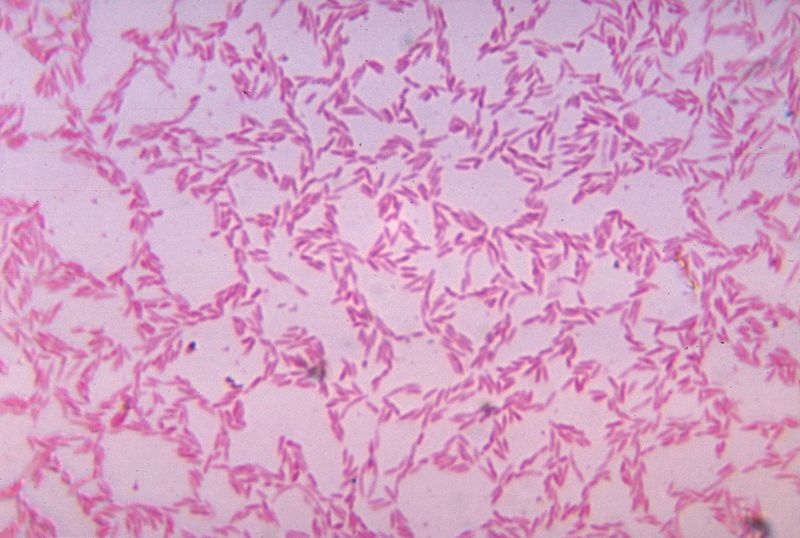 First the team raised animals in sterile conditions to prevent them from becoming colonised with any gut bugs. Apart from being less healthy from the outset compared with control animals, when these animals were challenged with a bacterial species called Helicobacter hepaticus they developed gut ulceration and inflammation. But a prior dose of Bacteroides fragilis prevented the inflammation, as did giving just the PSA molecule in the diet.
First the team raised animals in sterile conditions to prevent them from becoming colonised with any gut bugs. Apart from being less healthy from the outset compared with control animals, when these animals were challenged with a bacterial species called Helicobacter hepaticus they developed gut ulceration and inflammation. But a prior dose of Bacteroides fragilis prevented the inflammation, as did giving just the PSA molecule in the diet.
On the other hand, giving the animals modified B. fragilis, which was unable to make PSA, made no difference, proving that the PSA was responsible for the effect. PSA works by blocking the production of inflammatory signals including one called IL17, whilst at the same time promoting the production of regulatory T cells and other hormones like IL10, which keep the immune response in check.
The key question to address now is whether PSA can alter the situation for patients with established inflammatory intestinal disorders, like Crohn's Disease and ulcerative colitis. Encouragingly, giving these patients doses of worms, which are thought to have similar chemical effects to PSA, can damp down the disease, suggesting that PSA could be the key to future therapies. Until it's proven though, it'll remain a gut feeling!
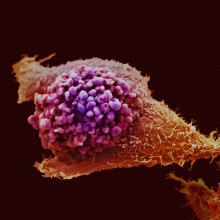
Prostate cancer discovers its female side
Prostate cancer affects more than 670,000 men worldwide, and researchers have known for a long time that the disease is fuelled by the male sex hormone testosterone. Men with prostate cancer are often given drugs that block the production or actions for testosterone in the body, and these treatments are often successful to start with, but their cancer eventually develops resistance and starts growing again.
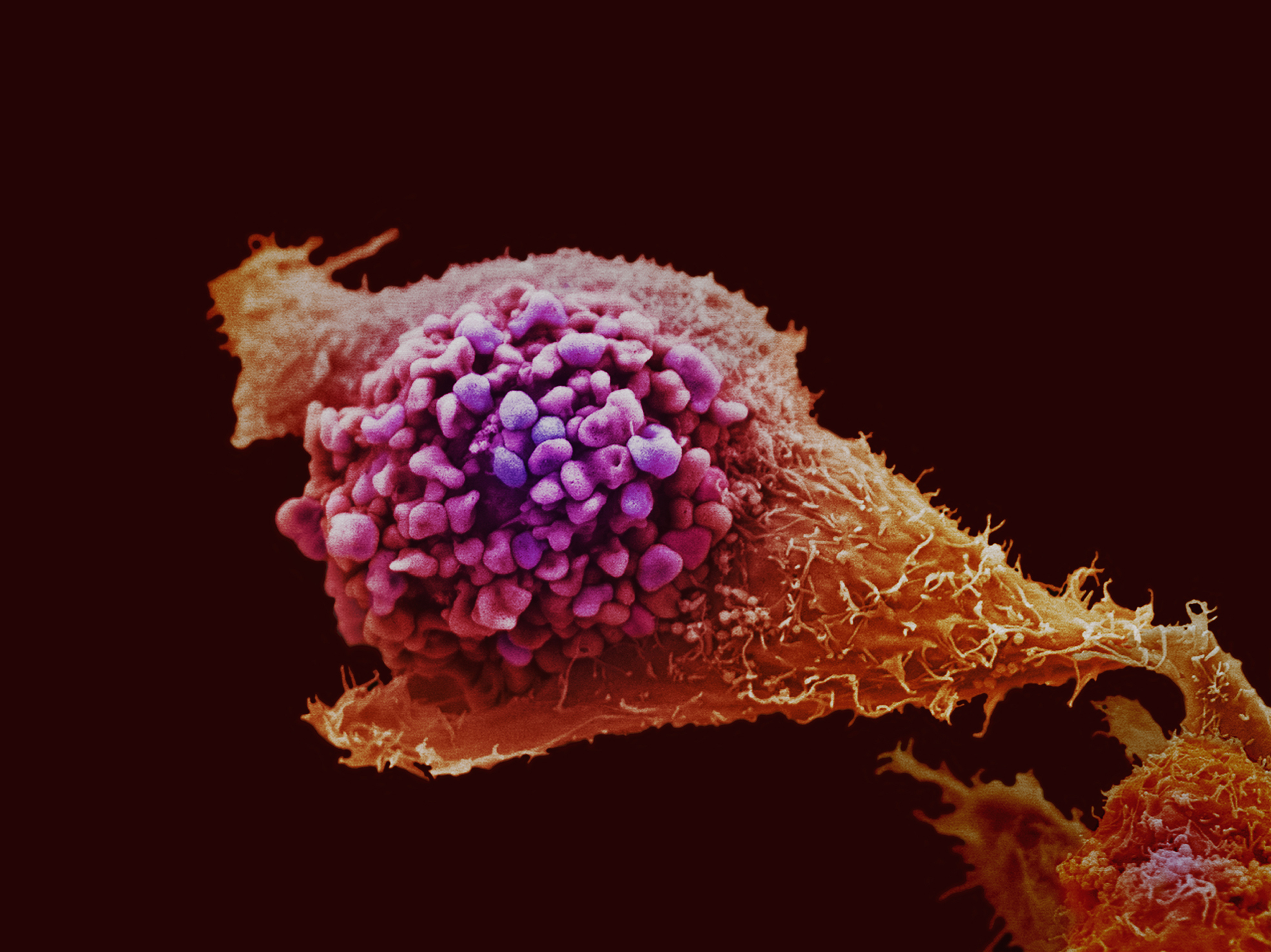 Now scientists at the New York Presbyterian Hospital and the Weill Cornell Medical Centre have made a surprising discovery that could make a big impact on the way that men are treated, if the results hold true.
Now scientists at the New York Presbyterian Hospital and the Weill Cornell Medical Centre have made a surprising discovery that could make a big impact on the way that men are treated, if the results hold true.
Led by Dr Mark Rubin, the scientists analysed the activity levels of more than 6,000 genes in 455 prostate cancer samples. They found that samples from more aggressive cancers appeared to be driven by a receptor for oestrogen, the female sex hormone.
To get a bit more detailed, around half of all aggressive prostate cancers are driven by a fusion protein, created when two important genes get spliced together. The researchers found that oestrogen can boost the activity of this fusion protein, fuelling the cancer growth.
But what does this mean for men with prostate cancer? We know that oestrogen plays an important role in fuelling breast cancer, and there are a number of very successful therapies for this disease that target the hormone. So this discovery raises the possibility that similar drugs could be used to treat men with aggressive prostate cancer. And, more speculatively, there's the possibility that oestrogen or oestrogen mimics in the environment might be helping to increase the risk of prostate cancer, or fuelling its growth.

Footballs could be the answer to the exploration of planets
Orbiters around planets such as Mars have given us an unprecedented view of the whole surface, but sometimes you actually have to go down and have a look. Last week the Mars Polar Lander touched down and will be digging holes and studying the chemistry, but only in one place. Rovers like Spirit and Opportunity can travel further, but in over 4 years they have only travelled a few km which isn't far on a whole planet.
 Researchers from Angstrom Aerospace in Sweden may have a solution to this problem. Their design involves putting the rover in what is basically a football. You put an axel across an inflatable sphere and then hang all the batteries and electronics below it, a bit like a pendulum. By moving this pendulum the robot can twist the axle and make the ball roll, and if it wants to steer it moves the pendulum to one or other side. The idea is to attach cameras and probes at the ends of the axle and if the robot wants to take a sample it can just tip over onto it's side.
Researchers from Angstrom Aerospace in Sweden may have a solution to this problem. Their design involves putting the rover in what is basically a football. You put an axel across an inflatable sphere and then hang all the batteries and electronics below it, a bit like a pendulum. By moving this pendulum the robot can twist the axle and make the ball roll, and if it wants to steer it moves the pendulum to one or other side. The idea is to attach cameras and probes at the ends of the axle and if the robot wants to take a sample it can just tip over onto it's side.
As the robot is inflatable it will take up about half of the space of an equivalent robot, and because it is fundamentally a football, it rolls really efficiently and you are much less worried about bumping into things. So it should be able to get up to about 30km/hr and travel about 100km on a battery charge, Then it would have to recharge it's batteries from flexible solar panels build into its skin.
The researches propose using these small robots as scouts for larger wheeled robots which would carry more sophisticated sensors
![Hoaxed telekinesis photograph French spirit photographer Édouard Isidore Buguet (1840-1901) demonstrates telekinesis in this hoaxed 1875 photograph titled Fluidic Effect. Buguet was arrested the same year for faking his ghost photographs and he served a year in prison. [1] The...](https://www.thenakedscientists.com/sites/default/files/styles/medium/public/media/Edouard-Isidore-Buguet-PK-spirit-photographer.jpg?itok=Vb48pgq8)
Movement by the power of thought
US researchers have developed a system which translates brain activity into movements of a prosthetic arm, a discovery which could help patients paralysed by strokes, injuries and other diseases to regain their independence.
Writing in this week's Nature, University of Pittsburgh researcher Andrew Schwartz and his colleagues have successfully trained monkeys to use their thoughts to feed themselves with a robot. The monkeys were each fitted with a small implantable electrode which was inserted into the main motor area on one side of the brain.The electrodes were able to pick up the electrical chatter of nerve cells signaling to each other about the next movement the animal was going to make. This activity was relayed to a computer which decoded the nerve signals and turned them into movements of a robot arm sitting beside the animal. With time and training, just by thinking along the right lines, the monkeys were able to use the robot arm to reach out to a variety of locations and to pick up a food item and return it to their mouths with high accuracy.
The trick that the team have used is to develop a way to accurately interpret the neurological signals that encode the direction and speed of planned movements. Scientists have discovered that individual motor nerve cells become most active when a movement takes place in a certain direction preferred by that cell. Movements in other directions tend to excite the cell less. This means that by eavesdropping on the activity of a large number of cells simultaneously it's possible to work out the direction of the planned movement, and this is the information then sent to the robot.
The work marks a major step forward in the field, which previously offered paralysed patients little more than the ability to move a cursor around a screen. A system like this could, theoretically, be linked back up to a paralysed person's own muscles, or used to allow an amputee to precisely and naturally control a prosthesis.
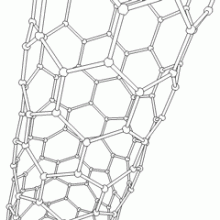
Nano nightmare or not?
Ever since Prince Charles' infamous "grey goo" speech, there have been concerns about the safety of nanoparticles in the environment. Adding fuel to the fire, last week researchers in Edinburgh published results in the journal Nature Nanotechnology showing that carbon nanotubes of a certain length could cause damage and inflammation in the lungs, similar to the effects of asbestos.
 But all nanoparticles are not the same. Writing in the same journal, scientists from the US National Institute of Standards and Technology studied whether fluorescent nanoparticles, called quantum dots, could build up in a food chain. Quantum dots are being studied for their use in a number of potentially useful application, including medical diagnostic techniques and treatments. This is important information to find out, as pollutants tend to get concentrated as you go up the food chain, and can poison larger predators.
But all nanoparticles are not the same. Writing in the same journal, scientists from the US National Institute of Standards and Technology studied whether fluorescent nanoparticles, called quantum dots, could build up in a food chain. Quantum dots are being studied for their use in a number of potentially useful application, including medical diagnostic techniques and treatments. This is important information to find out, as pollutants tend to get concentrated as you go up the food chain, and can poison larger predators.
The scientists used a simple food chain of just two aquatic organisms - a predator species and its single-celled prey. The team found that although the prey species took up the quantum dots, and they were passed onto the predators when they ate them, the amount transferred was relatively low, and the dots didn't appear to build up in the predators.
The researchers stress that these are just early results, and shouldn't be extrapolated too much. But it's a promising sign that at least some types of nanoparticles might not be the noxious nightmare that Prince Charles would have us believe.
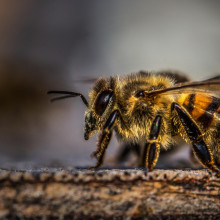
Do Bees have knees?
This is a really good question and in fact they do. Bees do have segmented legs, consisting of parts called a coax, a trochanter, a femur, a tibia and a tarsus. The jointw between which must be considered to be 'knees'.
There's been some discussion on the Naked Scientists' forum about this and Turnipsock suggests that perhaps the expression "The Bee's Knees" comes from the fact that they store pollen in these hairy baskets on their knees. They have hairs on their knees which are used to collect a big build-up of pollen. So, this could look like something very big and spectacular, hence the expression.
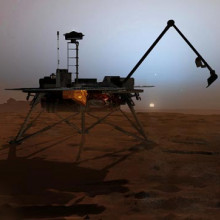
18:48 - Mars Update - Did Phoenix Land Safely?
Mars Update - Did Phoenix Land Safely?
with William Boynton, University of Arizona
Fortunately the Phoenix mission did land safely last week which was much to the relief of William Boynton. He's part of that mission. He designed something called the Thermal and Evolved Gas experiment which is analysing the Martian soil. He's from the University of Arizona and he's with us again to give us an update. Hello William.
William - Hello there.
Chris - Thank you for joining us again this week on the Naked Scientists. We thought we'd catch up to find out, now we've established Phoenix has landed safely, what it is that you'll now be doing over the next few months to understand more about the surface of Mars.
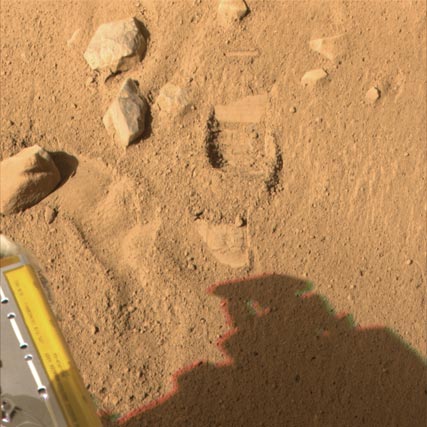 William - Yes. Well, first of all we're incredibly excited that we've got there. That was really a hairy time when we're not sure everything's going to work but we did eventually get down to the ground and that's good. This last week we've been going through what's called a characterisation phase which is where we're really trying to look around us and take some pictures and map out the landscape so we know what we're working with. It's going to be another three or four days before we get down to actually collecting samples and doing the analyses of them with the various analytical instruments that are brought landward.
William - Yes. Well, first of all we're incredibly excited that we've got there. That was really a hairy time when we're not sure everything's going to work but we did eventually get down to the ground and that's good. This last week we've been going through what's called a characterisation phase which is where we're really trying to look around us and take some pictures and map out the landscape so we know what we're working with. It's going to be another three or four days before we get down to actually collecting samples and doing the analyses of them with the various analytical instruments that are brought landward.
Chris - What sorts of experiments will you do?
William - Well, the instrument that I'm responsible for, as you mentioned, which we call a TEGA. It will take some of the soil and ice samples that are dug up by the robotic arm. It puts them into a very tiny oven. We heat the samples up in the oven and there's two things we're looking for. If there are any phase transitions: this is for example if we have ice when we heat it up to 0 Celsius it will melt. It takes more heat to do that and so we are keeping track of the heat required to raise [temperature of] the sample. That way we can tell how much ice is in the oven. The other thing that we're doing is we're looking at the gases that are given off by the sample as we heat it. We pass the gas on to the evolved gas analyser which has a mass spectrometer analyser in it and tells us what gases are given off. If we see water come off at a certain temperature that can tell us the nature of the mineral that evolved the water.
Chris - What are the big questions that you'll be answering with these experiments?
William - With that particular one we'll be just looking to see how much ice is present, mixed in with the soil. We actually think it's very high ice content once we get beneath the soil. We'll be looking for isotopic ratios. This is, for the same element, two different nuclei that have the different masses. The most important one is for hydrogen. Normally it's mass 1 but there's another form of it called deuterium which is mass 2. The ratio of those two things can tell us something about the history of the water and the temperature at which the ice formed in the past, things like that. We do have one other part of it that we're very hopeful will get some interesting results. We will be looking at organic compounds that might be evolved from the soil as we heat it up to high temperatures.
Dave - What does Mars look like where you've landed?
William - Perhaps surprisingly it looks pretty much as we expected. It's kind of interesting before all of these missions land there's usually some artist's concept of what the lander's going to look like on the surface and things that are passed around to the press and so forth. This time it was actually quite remarkable that the artist's concept agrees pretty much with what we see. We see a very, very flat region with very little topography. We're also on this region called patterned ground or polygonal terrain. What we find is that we land in this area which is filled with these polygons that range in size from a few metres up to really quite large ones. This is due to cracking of the ice. During the very cold winters on Mars the ice will contract and shrink and it leaves cracks. Then in the summertime it expands and the ice expands back to fill the crack. Meanwhile some dirt has fallen back into the crack and after many years of this we end up with this polygons which are formed by these cracks.
Chris - Looking at how you're managing to survive on Earth at the moment, William, I understand that you're living on Mars time. How does that work?
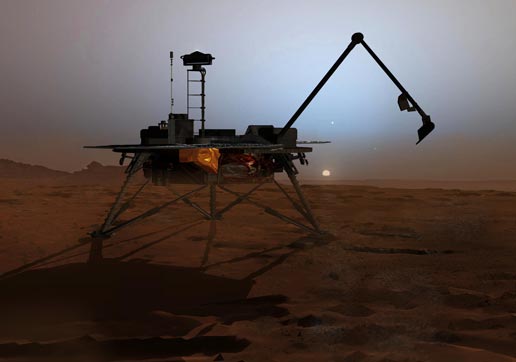 William - It turns out this lander is powered by solar cells and so it's only in the middle of the day. Actually from about 9am to 5pm local time on Mars that we have enough sunlight to efficiently operate the lander. We're in the high latitudes in summer so there's some sunlight shining on the lander all the time but really not enough to power it. The lander goes to sleep every day about 6pm local time and will wake up about 8 or 9am local time. It turns out Mars' day is about 40 minutes longer than an Earth day and so we can only operate that on this 24 hour and 40 minute cycle.
William - It turns out this lander is powered by solar cells and so it's only in the middle of the day. Actually from about 9am to 5pm local time on Mars that we have enough sunlight to efficiently operate the lander. We're in the high latitudes in summer so there's some sunlight shining on the lander all the time but really not enough to power it. The lander goes to sleep every day about 6pm local time and will wake up about 8 or 9am local time. It turns out Mars' day is about 40 minutes longer than an Earth day and so we can only operate that on this 24 hour and 40 minute cycle.
Chris - So your days are getting 40 minutes longer every day?
William - Yes, our days are getting 400 minutes longer every day because we have to be there when the lander goes to bed and sends down the data for us to look at.
Chris - You have my sympathy. I'm sure your body clock is now totally screwed.
William - It is really messed up. It's like perpetual jet lag of 40 minutes more each day.
Chris - Good luck with that, William!
What would happen if two planets collide?
Well, let's start off with something a bit smaller. When the impact which we think wiped out the dinosaurs hit; a 10-15km asteroid was thought to have hit somewhere in Mexico in Chicxulub. Just the 10-15km asteroid hitting the Earth released about the same energy as 100,000,000,000,000 tonnes of dynamite exploding (or TNT). Just to compare to that, the biggest nuclear bomb we've ever built was the equivalent of 50,000,000 tonnes of TNT. If you scale that up to something the size of a planet so several thousand kilometres across the amount of energy released is going to be absolutely immense. We think that Earth was originally hit, or what we call proto-Earth - Thea, was hit by an object the size of Mars about 4.5 billion years ago. When this hit the Earth it collided and released absolutely immense amount of energy. It completely melted everything in the Earth. The core of the other planet went in and ended up coalescing with the core of the Earth and then there was a load of stuff thrown out: an immense amount of the lighter rocks on the surface. These coalesced into a ring and then probably coalesced into the moon. So the moon is made of much lighter rocks than the Earth. The Earth is denser than it ought to be because it's just the two cores.
If you have a planetary collision it's messy but it can give rise to whole new worlds!
How do hairs go grey?
The first thing to note is that grey hairs are not grey. They're actually white because hair colour is determined by pigment that is made by hair follicle cells. There comes a time in everyone's life where basically the pigment stops being produced. You start producing hairs that have no pigment so they're white. This mixed with your hair colour gives the grey effect. Rather than hairs starting coloured and going white, although that is possible, you tend to get hairs that start off being white.
Another question is, does people's hair really go grey overnight?
Kat: I have looked at it a bit and there seems to be a bit of an argument in it. The only way I can see it's possible is if someone has very short hair. They go grey due to some stress event. Maybe their hair's falling out. It might look like over a very short period of time if you have very short hair that you're going grey overnight.
Chris: I've seen patients who have a hair which they've showed me themselves and say, "This is interesting doc, look at this." It's white at the base and then brown halfway along because it's literally run out of melanin to add to the hair and it's changed colour.
Burp-related Optical Illusions?
This is a fantastic question! You can achieve the same effect, not necessarily with an up thrust of wind, but also by crunching your cereal. If you were to go along in a car and eat some cereal at the same time you would see the same effect. Also, if you've got an LED clock radio at home you can achieve the same optical illusion looking at the display - the numbers appear to jump or flicker on and off as you chew.
What's happening is you're creating your own in-body stroboscopic effect. The vibrations when you're eating are being transmitted to your eyeballs and they're making your eyeballs move very slightly. This rapid eyeball movement is capturing the movement just the right way of those nuts going round the wheel or the flickering of LED clock lights. So this creates the appearance of jumping or freezing or switching off for a fraction of a second. It's literally your eyes moving together in unison as a result of crunching or burping or making a movement which jolts your eyeballs a little bit in your head.
Vampires and Soylent Green?
Yes. In theory you could do that. Blood is actually full of protein and it's full of iron, which you need in your diet. Don't forget that black pudding is just congealed blood that you fry. Blood also contains water which you need and there are some salts in there, so you can get protein, salt and iron from drinking blood.
There will be other things that you can't get from blood like water-soluble vitamins which are not present in large amounts. There will also be some fat-soluble vitamins which don't appear in large amounts in blood. You can probably make a reasonable meal out of blood but it wouldn't make up for all of your dietary requirements and so you might want to eat some freeze dried body pellets to supplement your intake. That's no different, really, from eating a microwave meal which is effectively just a dried out bit of body. It may not be human, it's just animal instead.
Why is the moon sometimes visible during the day?
We've gone to the forum for this one. Basically it's visible because when it's in the sky it's just another object being lit by the sun. So when it's in the right place we can see it. The moon is orbiting the Earth once every 28ish days. You can't see it during the day if it's right between us and the sun because the back of it, which isn't lit up by the sun, is pointed towards us. If the moon is around 45 degrees off the sun or even 90 degrees off the sun then half of it will be lit up really quite brightly. Then the surface of the moon is about as bright as the surface of the Earth is. There's no reason why you shouldn't be able to see it! As long as the moon's at 45 degrees the sunward side of the Earth and it's lit reasonably you'll be able to see it.
Why does red hair go white?
The process is very likely to be the same as any other hair colour. All you're doing is losing from the hair the ability to add some colour. The colour is accounted for by different forms of melanin: the same hormone, the same chemical in the skin that makes you go brown. You just lose the ability to add that to the hair so you see the natural colour of the hair: the keratin and that's the stuff which is white.
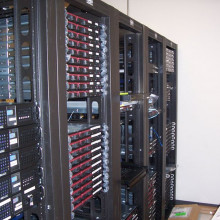
33:08 - Cooling The Web - Data Centres Adding to Climate Change
Cooling The Web - Data Centres Adding to Climate Change
with Chris Vallance
Meera - Airlines often get a lot of criticism from the green movement for the amount of greenhouse gases they emit. According to a new report another industry could soon be overtaking them in this area. I've come down to London to meet up with our resident tech expert, Chris Vallance, to find out more. Chris, what industry is causing all the problems?
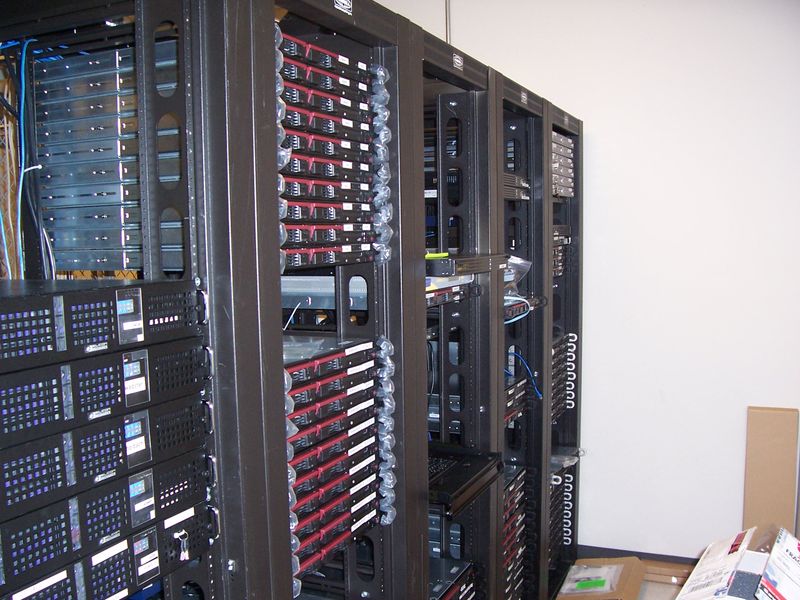 Chris V - It comes from a surprising quarter. These are data centres. These are the vast collections of computers that power everything from online banking to, let's say, dancing hamsters if you watch those. They are these big computer warehouses that power the internet. They do produce a lot of greenhouse gases. A report by McKinsey and Co. suggests that by 2012-2015 they could overtake the airline industry in terms of the amount of greenhouse gases they produce.
Chris V - It comes from a surprising quarter. These are data centres. These are the vast collections of computers that power everything from online banking to, let's say, dancing hamsters if you watch those. They are these big computer warehouses that power the internet. They do produce a lot of greenhouse gases. A report by McKinsey and Co. suggests that by 2012-2015 they could overtake the airline industry in terms of the amount of greenhouse gases they produce.
Meera - How do they produce so many emissions?
Chris V - The reason is they consume an awful lot of electricity. They consume an incredible amount of power. To find out where that energy goes and how they use it I went to visit one data centre. I can't say where it is, I can't say who it is and I can't say who I spoke to other than to say he was the person sort of in charge. His name was John and he took me on a tour of the data centre.
Chris V - The room is filled with large cabinets about the size of one of those fridges you might have at home. Each one is a rack of processing power, that computer processing generates a lot of heat. Standing in front of this I can feel the heat coming off the back. That heat has to be taken away and if we come round the front the floor is a little bit Marilyn Monroe. It's filled with air conditioning. There's cold air rushing up from beneath us to take that heat away. These computers obviously generate a lot of heat.
John - Typically in this industry: six seven years ago you'd look at your typical cabinet would produce 300W, maybe 400W of power. 3 or 4 light bulbs' worth. You look at your modern blade servers: you can fit maybe four chassis into a computer cabinet each taking 4kW so you're looking at 16kW of power. That's 8 two-bar heaters for each cabinet.
Chris V - This room is filled with those cabinets so that's a lot of heat. You can imagine this room being filled with two-bar heaters.
John - Absolutely, Chris. Heat rejection is becoming a bigger and bigger industry.
Chris V - We're on the roof of the building and in front of me, pretty much the entire roof space has been given over to air conditioning fans. John, I guess these are taking the heat away from those processors.
John - That's correct Chris. We're looking at, probably 2.5 maybe 3MW of heat being rejected from this roof at the moment.
Chris V - To give a sense of how much energy that is, that would be enough electrical energy to power 1000 homes?
John - Pretty much exactly right, yes.
Chris V - 3MW of heat. And this is just going into space at the moment?
John - That's correct. It's just going into space.
Meera - That was an insight into the world of data centres. It sounds like it's the amount of power they consume that's causing the problem.
Chris V - It's the power needed to run those vast collections of computers and then the power needed to cool them. I was told that, for every watt into a data centre computer it takes about 0.6-0.7 of a watt to actually cool that computer.
Meera - Is anything in progress to improve the situation?
 Chris V - Well, there are lots of efforts to try and make data centres more efficient. One of the ideas being proposed is that you could use the heat from data centres to do things like heat homes or heat swimming pools. The problem with that is data centres seem to get rid of the most heat on hot days which is when people least want heated swimming pools or heated homes. Perhaps there's only a limited use you can do with that. The main focus is on making the data centres more efficient so they actually consume less power.
Chris V - Well, there are lots of efforts to try and make data centres more efficient. One of the ideas being proposed is that you could use the heat from data centres to do things like heat homes or heat swimming pools. The problem with that is data centres seem to get rid of the most heat on hot days which is when people least want heated swimming pools or heated homes. Perhaps there's only a limited use you can do with that. The main focus is on making the data centres more efficient so they actually consume less power.
Meera - If they're causing the problems should we just stop going online to buy things then?
Chris V - Far from it. Obviously when we do online shopping or online banking the one thing we're not doing is driving our car to the shops or the bank so this activity of data centres, in a way, helps us save emissions. Perhaps they could cause less emissions than they do now. That's the challenge.
And to put some numbers on that claim, the report mentioned by Chris actually found that data centres emit about 0.3% of the world's total carbon dioxide, which is 170 million tonnes every year. And to put that into perspective; that's more than some entire countries release: Argentina and the Netherlands for instance both contribute less CO2 in total than data centres do!
Mereorite and Asteroid Questions?
This is a semantics issue. A meteor is a lump of rock on collision course with something - they're whizzing towards them. When they hit the ground they become a meteorite - a congealed lump of rock which has melted on the way through and landed on the ground. So a meteorite is something which has made it to a planet's surface. An asteroid is a huge chunk of debris left in space which is effectively a failed planet that never managed to form.

Impact craters on the Moon?
The same amount of energy will throw more material around.
However, because the moon has less gravity, the same size meteor hitting the moon will have less energy than it would if it hit the Earth.
For a collision with the same amount of energy you'll get a bigger crater on the moon.
The big effect on the moon is they're not getting eroded all the time by wind and weather.

40:58 - Chemistry Update - Mosquitoes, Bubbles and Superconductors
Chemistry Update - Mosquitoes, Bubbles and Superconductors
with Mark Peplow, Chemistry World
Chris - What's all this about computers designing new ways to ward of mosquitoes?
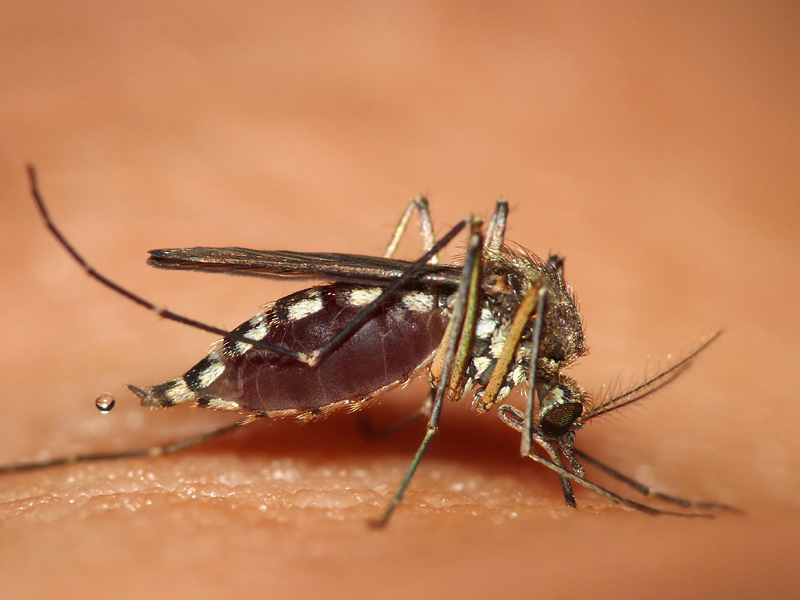 Mark - This is fantastic. The chemical compound, DEET is the gold standard in insect repellents. The University of Florida scientists have trained a computer to come up with even better repellents. Basically they took an artificial neural network which is kind of a computer programme that's trained to recognise patterns in huge, complex sets of data. They let it loose on the US Department of Agriculture's database of insect repellents. 60 years' worth of data, 40,000 chemical structures. It slowly learned, with some help from the scientists, how to relate the structure of the compound, the position of atoms to its activity as an insect repellent. Then they gave it 2000 new chemical structures, many of which had never been created, to have a look at. It picked out 11 previously known molecules and 23 completely new and had to be synthesised. When the chemists actually made these molecules and tested them next to DEET they found they were much better in some cases. They were active for 73 days as opposed to 17.5 days.
Mark - This is fantastic. The chemical compound, DEET is the gold standard in insect repellents. The University of Florida scientists have trained a computer to come up with even better repellents. Basically they took an artificial neural network which is kind of a computer programme that's trained to recognise patterns in huge, complex sets of data. They let it loose on the US Department of Agriculture's database of insect repellents. 60 years' worth of data, 40,000 chemical structures. It slowly learned, with some help from the scientists, how to relate the structure of the compound, the position of atoms to its activity as an insect repellent. Then they gave it 2000 new chemical structures, many of which had never been created, to have a look at. It picked out 11 previously known molecules and 23 completely new and had to be synthesised. When the chemists actually made these molecules and tested them next to DEET they found they were much better in some cases. They were active for 73 days as opposed to 17.5 days.
Chris - Could they be applied to the skin safely without risk to health?
Mark - Certainly the quickest way to try these things is to try them on your skin. Indeed, the fearless chemists did try these out with little swabs, patches with this chemical absorbed - stuck onto their skin. This is obviously a little way from being a new insect repellent going on the market. They have identified the best seven compounds which are now under further study.
Chris - It's very exciting because mosquitoes are responsible for spreading so many diseases. Incidentally on of those chemists who tested it is just having his other arm removed as we speak. There's another interesting thing here about bubbles that can last for donkey's years.
 Mark - A year at least. Gas bubbles are an essential part of everything from ice cream, foams, paint. The size of the bubbles really affects their properties. The trouble is that bubbles less than a micrometre in size, just a millionth of a metre, are really hard to make. The trouble is smaller bubbles tend to aggregate and merge into bigger ones. Now a group of scientists at Unilever, the people who make everything from paint to ice cream to washing powder, teamed up with people from Harvard University. They found a way to make microbubbles that last longer than a year. Basically they've used a really clever mix of surfactants. They're often used in detergents to keep oil, grease and water apart. These are molecules that look kind of like little tadpoles. They have a water-loving head and a fat-loving tail. These tadpole molecules all line up in a big sphere and actually encapsulate and stabilise these microbubbles.
Mark - A year at least. Gas bubbles are an essential part of everything from ice cream, foams, paint. The size of the bubbles really affects their properties. The trouble is that bubbles less than a micrometre in size, just a millionth of a metre, are really hard to make. The trouble is smaller bubbles tend to aggregate and merge into bigger ones. Now a group of scientists at Unilever, the people who make everything from paint to ice cream to washing powder, teamed up with people from Harvard University. They found a way to make microbubbles that last longer than a year. Basically they've used a really clever mix of surfactants. They're often used in detergents to keep oil, grease and water apart. These are molecules that look kind of like little tadpoles. They have a water-loving head and a fat-loving tail. These tadpole molecules all line up in a big sphere and actually encapsulate and stabilise these microbubbles.
Chris - So it would mean better paints, better ice cream?
Mark - Exactly. If you think about it beer is a good example. If you think about the difference in taste between Guinness and the lager a lot of it is to do with the feel of it on your tongue. You have really big fat bubbles in lager and tiny little microbubbles in Guinness so all these things are very important for the chemists that make, like I said, everything from ice cream to paint.
Chris - Thank you, Mark. Lastly, superconductors. This is really big business. We've heard about data centres consuming enormous amounts of energy and being very bad for the environment but superconductors are a way of potentially alleviating that problem if we can find a way to make them work.
Mark - It's one of the challenges which is, I think, up there alongside developing fusion power. Superconductors carry electricity with no resistance at all. There are already many small-scale uses for them. If you could use them on a very large scale replacing cables on a power grid you could transform the way we use energy. Resistance takes up about 10% of power that's pumped into the American grid, for example. The trouble is superconductivity only switches on at very low temperatures. About 20 years ago scientists found some copper-based compounds which are our best candidates for high temperature superconductors. They start doing that at -135 degrees.
Chris - But it's still -135 degrees.
Mark - It's still pretty chilly. The trouble is progress stalled at that stage and no one knows how they work and for a decade no one's been able to improve much on that temperature. In the last three months about half a dozen different groups in China and Japan have made really rapid progress with a completely different set of compounds. Instead of copper and oxygen atoms in these compounds they have iron and arsenic. There's a smattering of other elements which they've been tweaking: lanthanum, samarium. Exotic things. Already in three months they've seen a 30 degree improvement in these compounds which in the field is quite a significant improvement. That superconducting temperature, that threshold temperature is still at -218 so it's a long way from being practical but they key thing is it's revitalised a field where physicists had been banging their head against the wall for ten years, making very little progress. Crucially these are the best alternative candidates you can actually compare to. No one really knows how these materials really work. If you've got one set of copper-based compounds you can now compare them to these new iron compounds and try and work out how they're functioning.
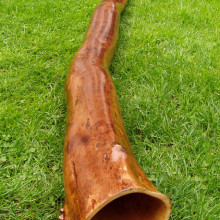
46:41 - Inner Workings of Didgeridoos?
Inner Workings of Didgeridoos?
Neville Fletcher, Australia National University:
Over the past few years we've been doing a nice research project on the didgeridoo. It's the trunk of a small tree that's been hollowed out by termites, cleaned out, and somewhere between 1 and 1.5m long typically. It can either be pretty much cylindrical or flaring a bit depending on the sort of tree it's come from. It's played by blowing it very much as you would blow a trumpet or a trombone by vibrating your lips. The longer the didgeridoo the lower the note it will make. If it's about 1.5m long it makes a drone which is about 2 octaves below middle C. That's about 65 vibrations per second, if it's cylindrical. If it's conical so that it flares out at the far end then it plays a higher note. And if it's shorter it also plays a higher not rather like the fact that a trumpet plays a much higher note than a trombone, for instance.
The main thing about a didgeridoo is that you can change the actual sound quality and doing that the player changes the shape of his mouth by moving his tongue: very much as you would if you're saying vowels. If you go, "aaaeeeiiiuuu." In addition people have developed a technique called circular breathing where you fill up your cheeks with air to keep the drone going and then you quickly snatch a breath through your nose. You can keep the sound going for minutes and minutes at a time.
Why can birds touch electricity wires?
Well, actually you could sit on an electricity wire and not get electrocuted as long as you didn't touch anything else. The birds aren't doing anything special. The reason they're able to sit there is because they're not earthing or producing a route for the electricity to get from the wire down to the ground. If you were to hang on to the wire and touch the pylon that's holding the wire then you'd have a problem. The wires are at a very high voltage, the pylon's at a very low voltage and you provide a very convenient circuit down to earth for the electricity. The birds that are sitting on the wire there's no difference in potential between one leg and the other. Both legs are sitting on the wire so there's no reason for the electricity to want to flow through them.
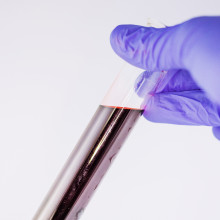
If we bleed in a vacuum would it bleed blue?
The answer is definitely no!
In hospital they use things called vacutainers which is a vacuum in a tube. You put a needle into a patient's vein, put the tube onto the needle and this exposes the inside of the vein to the vacuum and draws the blood into the tube. Momentarily the blood is exposed to a vacuum and the blood comes out very red. There's still too much oxygen in venous blood to make sure it stays a red colour. So why do veins look blue?
This is because when you have a bit of the tissue which doesn't have enough bloodflow going through it tissue will remove more oxygen from the blood. It does mean haemoglobin can get to be a blue colour.
Normally that doesn't happen but if you have an area of the body that doesn't have enough bloodflow through it then the tissue gets oxygen hungry and removes enough oxygen to make it go blue. Veins look blue as an optical illusion. They're not really blue and if you cut through the skin you'll see they're a whitish pink colour.

Why does the road surface appear to shimmer when it's hot?
When air is hot it expands and light will go through hot air slightly faster than cold air. When light changes its speed at an angle it will bend like when it goes into glass or something. You get lots of turbulence with air moving up which light will go through faster. So you get light bending in all sorts of directions which change as the air moves and you get this turbulence effect. The same effect makes stars twinkle, as you get turbulence up in the atmosphere which bends the light coming from stars which makes them twinkle on and off. Sometimes they come towards you, sometimes they go the other way.
- Previous The Science of the Didgeridoo
- Next Future Power and Outer Space
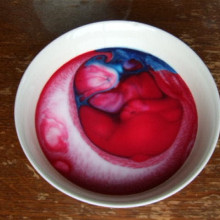









Comments
Add a comment